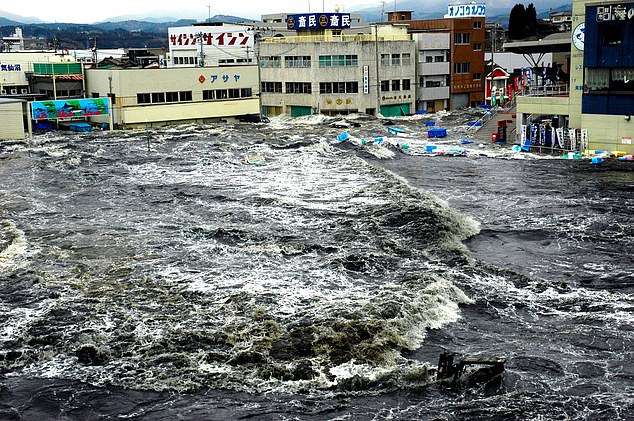Tsunami fears in Japan after deep-sea fish associated with natural disasters are discovered by fishermen
Sun 03 Feb 2019, 11:38:56

Japanese social media has been flooded with rumours of an impending natural disaster after mysterious deep-sea fish began washing up on its coast.
In the last ten days, three oarfish have been found around Toyama Bay, despite the fact that they live 3,000ft down in the deep ocean and rarely surface, the South China Morning Post reports.
Legend says that oarfish, which are known as 'messengers from the sea god's palace' in Japanese, will rise up and beach themselves ahead of an earthquake.
In the days before the 2011 Tohoku earthquake, around 20 of the fish were found washed up in north eastern Japan, Live Science reports.
The quake that followed was one of the most destructive in recent history, killing 19,000 people and destroying the Fukushima nuclear power plant.
Dozens of the fish were also discovered ahead of an 8.8 magnitude earthquake which struck Chile in 2010.
Another oarfish was found on a beach in Agusan del Norte in the Philippines just days before a killer earthquake ravaged Mindanao island on 11 February.
Five more oarfish were found around the coast in the days following the 6.3 quake.
While scientists caution that there is no definitive link between oarfish sightings and quakes, researchers admit it is possible they could sense natural disasters.
Rachel Grant, a lecturer in animal biology at Anglia Ruskin University in Cambridge, told Euronews: 'When an earthquake
occurs there can be a build-up of pressure in the rocks which can lead to electrostatic charges that cause electrically-charged ions to be released into the water.
In the last ten days, three oarfish have been found around Toyama Bay, despite the fact that they live 3,000ft down in the deep ocean and rarely surface, the South China Morning Post reports.
Legend says that oarfish, which are known as 'messengers from the sea god's palace' in Japanese, will rise up and beach themselves ahead of an earthquake.
In the days before the 2011 Tohoku earthquake, around 20 of the fish were found washed up in north eastern Japan, Live Science reports.
The quake that followed was one of the most destructive in recent history, killing 19,000 people and destroying the Fukushima nuclear power plant.
Dozens of the fish were also discovered ahead of an 8.8 magnitude earthquake which struck Chile in 2010.
Another oarfish was found on a beach in Agusan del Norte in the Philippines just days before a killer earthquake ravaged Mindanao island on 11 February.
Five more oarfish were found around the coast in the days following the 6.3 quake.
While scientists caution that there is no definitive link between oarfish sightings and quakes, researchers admit it is possible they could sense natural disasters.
Rachel Grant, a lecturer in animal biology at Anglia Ruskin University in Cambridge, told Euronews: 'When an earthquake
occurs there can be a build-up of pressure in the rocks which can lead to electrostatic charges that cause electrically-charged ions to be released into the water.
'This can lead to the formation of hydrogen peroxide, which is a toxic compound. The charged ions can also oxidise organic matter which could either kill the fish or force them to leave the deep ocean and rise to the surface.'
The discovery of three fish in ten days around Toyama Bay - the record is four fish found in the whole of 2015 - has set tongues wagging.
Japan is criss-crossed by various fault lines and sits on the Pacific Ring of Fire, which has seen increased activity in recent years.
Of particular concern is the Nankai Trough, which sits along the country's east coast - the opposite side from Toyama Bay.
Experts believe any quake along this fault would cause widespread devastation and a huge loss of life, potentially wiping out large parts of Tokyo or Osaka - the two most populous cities in Japan.
Quakes here usually occur in pairs, with the last two in 1944 and 1946, killing a total of 2,500 people.
After the most recent discoveries, message on Twitter claimed: 'This is no doubt evidence of a precursor to an earthquake.
'And if it is in the Nankai Trough, it might be a huge quake.'
One Twitter user asked: 'Is something happening deep in the sea?'
Another questioned: 'What is going on under Toyama Bay?'
The discovery of three fish in ten days around Toyama Bay - the record is four fish found in the whole of 2015 - has set tongues wagging.
Japan is criss-crossed by various fault lines and sits on the Pacific Ring of Fire, which has seen increased activity in recent years.
Of particular concern is the Nankai Trough, which sits along the country's east coast - the opposite side from Toyama Bay.
Experts believe any quake along this fault would cause widespread devastation and a huge loss of life, potentially wiping out large parts of Tokyo or Osaka - the two most populous cities in Japan.
Quakes here usually occur in pairs, with the last two in 1944 and 1946, killing a total of 2,500 people.
After the most recent discoveries, message on Twitter claimed: 'This is no doubt evidence of a precursor to an earthquake.
'And if it is in the Nankai Trough, it might be a huge quake.'
One Twitter user asked: 'Is something happening deep in the sea?'
Another questioned: 'What is going on under Toyama Bay?'
No Comments For This Post, Be first to write a Comment.
Most viewed from International
Most viewed from World
AIMIM News
Latest Urdu News
Most Viewed
May 26, 2020
Do you think Canada-India relations will improve under New PM Mark Carney?
Latest Videos View All
Like Us
Home
About Us
Advertise With Us
All Polls
Epaper Archives
Privacy Policy
Contact Us
Download Etemaad App
© 2025 Etemaad Daily News, All Rights Reserved.



.jpg)




.jpg)
.jpg)
.jpg)









.jpg)

.jpg)
.jpg)
.jpg)

















